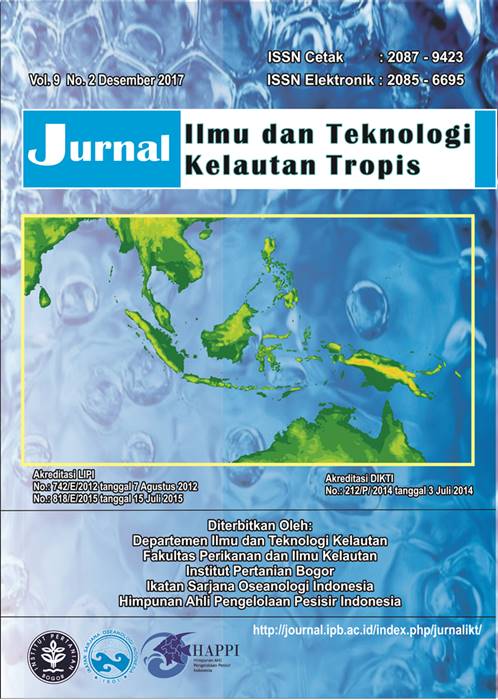GROWTH AND PROTEIN CONTENT OF Ulva prolifera MAINTAINED AT DIFFERENT FLOW RATES IN INTEGRATED AQUACULTURE SYSTEM
Abstract
Efforts to reduce the impact of waste improvement on degradation of water quality can be transferred by utilization of inorganic waste as a source of seaweed nutrition. This study aimed to determine the growth and protein content of Ulva prolifera maintained at different flow rates in integrated aquaculture system. 9 Yellowtail stocked with 5.095 g with an average weight of 566.11±81.51 g were kept in 540 L tank for 24 days, by water flowing at the rate of 10 L min-1. Water from the fish tank was distributed into the sediment tank and go to 6 Ulva tanks with the flow rate of 0.5, 1.0 and 1.5 L min-1. Test parameters measured were growth performance of Yellowtail, biomass of Ulva prolifera, protein content of Ulva prolifera, and total ammonia nitrogen. The measurement results showed that the biomass of fish increased to 5.408 g, then biomass of Ulva increased to 42 g, 156 g and 155 g for flow rate of 0.5 L, 1 L and 1.5 L min-1, respectively. The protein content of Ulva for all the treatments was the same (P> 0.05). A total of ammonia in the tank outlet of Ulva (0.0202 - 0.1137 mg N L-1) were smaller than those were in the inlet (0.0286 - 0.1394 mg N L-1).
Authors
This work is licensed under a Creative Commons Attribution 4.0 International License.
Jurnal Ilmu dan Teknologi Kelautan Tropis i is an open-access journal, meaning that all content is freely available without charge to the user or their institution. Users are allowed to read, download, copy, distribute, print, search, or link to the full texts of the articles in this journal without needing to request prior permission from the publisher or the author.
All articles published by Jurnal Ilmu dan Teknologi Kelautan Tropis are licensed under the Creative Commons Attribution 4.0 International License. This allows for unrestricted use, distribution, and reproduction in any medium, provided proper credit is given to the original authors.
Authors submitting manuscripts should understand and agree that the copyright of published manuscripts is retained by the authors. Copyright encompasses the exclusive rights of authors to reproduce, distribute, and sell any part of the journal articles in all forms and media. Reproduction of any part of this journal, its storage in databases, and its transmission by any form or media is allowed without written permission from Jurnal Ilmu dan Teknologi Kelautan Tropis.


